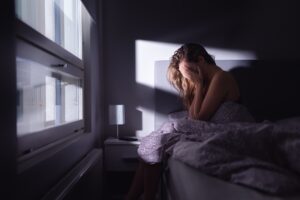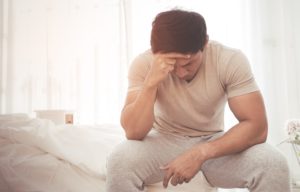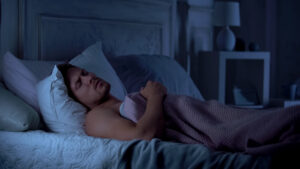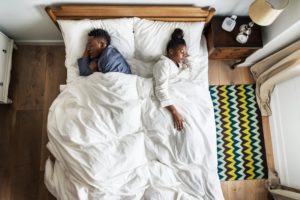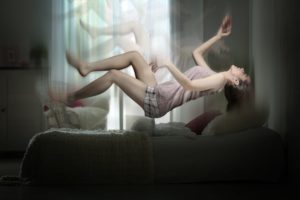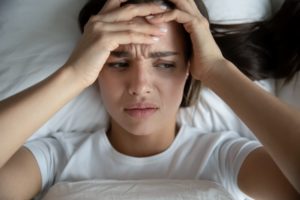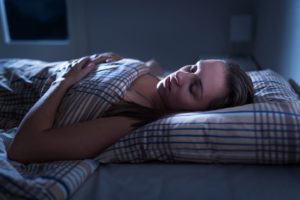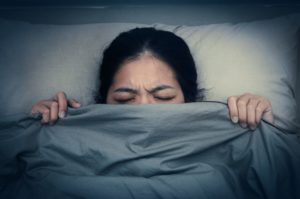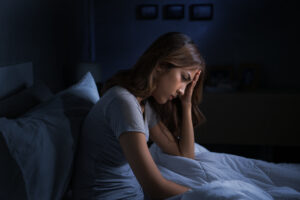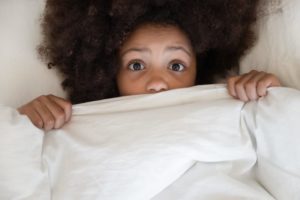When you buy through our links, we may earn a commission. Products or services may be offered by an affiliated entity. Learn more.
Confusional Arousals and Sleep Drunkenness
- Confusional arousal is a parasomnia characterized by disorientation during partial awakenings from deep sleep.
- Sleep drunkenness is the prolonged feeling of grogginess after waking.
- Symptoms include mumbling, poor coordination, and limited memory of the episode.
- Addressing health concerns is essential to the management of confusional arousal episodes.
Confusional arousal, also known as Elpenor syndrome, is a type of non-rapid eye movement (NREM) parasomnia. Other arousal parasomnias include sleep terrors and sleepwalking. These events cause you to have wakeful behaviors while apparently asleep.
During confusional arousal events, a person may have their eyes open or talk in their sleep, typically unaware of their behavior and unable to remember it afterward. Confusional arousals differ from other arousal disorders in that the person remains in bed, and they do not display an increased heart rate or other signs of terror. Sleep drunkenness can be a component of confusional arousals, but it also occurs as part of other disorders, such as idiopathic hypersomnia.
Although confusional arousals are considered an official sleep-wake disorder and sleep drunkenness has a more general meaning, the two terms are often used interchangeably.
What is Sleep Drunkenness?
Sleep drunkenness, or prolonged sleep inertia, refers to the groggy transitional state you experience between sleep and wakefulness . People who experience sleep drunkenness struggle to wake up fully and repeatedly fall back to sleep. They display confusion, irritability, and automatic behavior.
Estimates of how many people experience confusional arousals vary. One U.K. study found 4.2% of adults experience confusional arousals. Other studies have reported as many as 15.2% of adults experience confusional arousals in a year. The American Academy of Sleep Medicine notes that the disorder is more common in children, with 17% of children but just 3% or 4% of adults over 15 years old experiencing the condition. Often, children with confusional arousal disorder develop sleepwalking later in childhood or adolescence.
Causes of Confusional Arousals
Unlike rapid eye movement (REM) sleep behavior disorder, confusional arousals take place during non-rapid eye movement (NREM) sleep. NREM sleep includes the first three stages of sleep in which you transition from light sleep to deeper sleep , and it is not typically associated with vivid dreams. Confusional arousals most often occur when the sleeper is interrupted during deep sleep. They rarely happen during short naps, because the sleeper does not have time to enter deep sleep.
It is believed that confusional arousals result from different parts of the brain failing to fully communicate with each other, leading some to stay awake while others sleep. Confusional arousals may also be triggered by a number of other conditions that rouse the person from deep sleep:
- Obstructive sleep apnea
- Narcolepsy
- Periodic limb movement disorder
- Circadian rhythm sleep disorders
- Excessive sleep greater than 9 hours nightly
- A triggering event, such as a bright light, a phone ringing during sleep, or the need to go to the bathroom
Mental health disorders including bipolar disorder and panic disorder can also cause confusional arousals. Additionally, the use of antidepressant medications can impact confusional arousals. Possible causes of sleep drunkenness include night or shift work or working irregular hours.
Risk Factors for Confusional Arousals and Sleep Drunkenness
Confusional arousals often appear for the first time when a child is around 2 years old. The frequency of confusional arousals tends to lessen with age, with a marked decrease starting around the age of 5.
A number of factors may raise the risk of experiencing confusional arousals and sleep drunkenness:
- Excessive sleep and hypersomnolence disorders
- Insufficient sleep or stress
- Family history of NREM parasomnias
Gender is not among the risk factors for confusional arousals. Difficulty waking up and confusion when waking because of sleep drunkenness appears to affect men and women equally.
Symptoms of Confusional Arousals
Confusional arousals generally occur in the first third of the night, after the first or second deep sleep episode. The symptoms of confusional arousals include:
- Arousing suddenly, but not being fully awake
- Feeling confusion and disorientation
- Glassy stare
- Inappropriate response or lack of response to people nearby
- Mumbling, vocalizations, and sometimes coherent speech
- No memory of the events that occur
Confusional arousals have little to no connection with dreams.
Impacts of Confusional Arousals
Like other NREM parasomnias, confusional arousals pose certain risks. Frequent arousals can affect your daytime alertness. They can cause sleep deprivation and lead to excessive daytime sleepiness .
Most episodes last a few minutes, but some may last upwards of half an hour. Research shows that impairment during sleep inertia, even if less than 30 minutes, is equal to or worse than sleep loss . Work performance, memory, and reaction times may suffer.
Confusional arousals may also disturb sleeping partners. Although rare, during some arousals you might unintentionally cause harm to yourself or others nearby. Repeated experiences of confusional arousals may trigger psychological distress.
Diagnosing Confusional Arousals
Diagnosis for any NREM parasomnia requires eliminating possible medications, drugs, or other sleep or health disorders causing poor sleep. Sometimes polysomnography, or a sleep study, may be taken to determine the presence of a sleep disorder. Often a sleep diary and notes from a sleep partner are used to gain more insight into the parasomnia symptoms.
To qualify as a confusional arousal as opposed to another NREM parasomnia, the person must show confusion, and they must not leave the bed or display signs of terror.
Treatments for Confusional Arousals
Typically confusional arousals, including sleep drunkenness, are addressed by improving sleep time and quality. This may include following established sleep hygiene methods:
- Keep a regular sleep schedule, including over the weekends
- Create a relaxing bedtime routine, which may include reading, meditating, or taking a bath
- Exercise regularly during the daytime
- Limit naps to before 3 p.m.
- Avoid caffeine in the afternoon and evening hours
- Reduce or eliminate alcohol in the hours before bedtime
People who regularly experience confusional arousals should also strive to avoid known triggers and situations that lead to sleep deprivation. If you take medications that interfere with sleep, talk to your doctor to see if you can switch to another type.
Additionally, experts recommend you take safety steps to avoid the risk of injury caused by unintentional movement during sleep:
- Sleep on the ground floor and consider placing the mattress directly on the floor
- Sleep alone, or if sleeping with a partner, push two queen size mattresses together
- Inform potential sleeping partners of your condition
- Never share the bed with a child
- Leave ample space around the bed and add cushioning to furniture that is within reach
- Keep plastic bottles or cups by the bed for beverages, rather than glass cups
- Safety-proof door knobs and remove dangerous items
- Keep a nightlight within relatively easy access
In some instances, healthcare providers may suggest additional treatment methods for confusional arousals or sleep drunkenness, in combination with improved sleep hygiene.
When to Talk to Your Doctor
If you experience the symptoms of confusional arousals or sleep drunkenness, talk to your doctor. To provide a clear picture of your sleep habits, you might keep a sleep diary that you share with your doctor. If you have a sleep partner, they may be able to provide additional details about your experiences that they have witnessed.
Your doctor can help rule out possible other disorders and identify potential causes of the parasomnia. They can also help you develop an appropriate treatment plan.

Still have questions? Ask our community!
Join our Sleep Care Community — a trusted hub of sleep health professionals, product specialists, and people just like you. Whether you need expert sleep advice for your insomnia or you’re searching for the perfect mattress, we’ve got you covered. Get personalized guidance from the experts who know sleep best.
References
8 Sources
-
Flamand, M., Boudet, S., Lopes, R., Vignal, J. P., Reyns, N., Charley-Monaca, C., Peter-Derex, L., & Szurhaj, W. (2018). Confusional arousals during non-rapid eye movement sleep: Evidence from intracerebral recordings. Sleep, 41(10), 1–11.
https://pubmed.ncbi.nlm.nih.gov/30016508/ -
Trotti, L. M. (2017). Waking up is the hardest thing I do all day: Sleep inertia and sleep drunkenness. Sleep Medicine Reviews, 35, 76–84.
https://pubmed.ncbi.nlm.nih.gov/27692973/ -
Ohayon, M. M., Guilleminault, C., & Priest, R. G. (1999). Night terrors, sleepwalking, and confusional arousals in the general population. The Journal of Clinical Psychiatry, 60(4), 268–276.
https://pubmed.ncbi.nlm.nih.gov/10221293/ -
Ohayon, M. M., Mahowald, M. W., & Leger, D. (2014). Are confusional arousals pathological? Neurology, 83(9), 834–841.
https://pubmed.ncbi.nlm.nih.gov/25156346/ -
National Institute of Neurological Disorders and Strokes (NINDS). (2019, August 13). Brain basics: Understanding Sleep.
https://www.ninds.nih.gov/health-information/public-education/brain-basics/brain-basics-understanding-sleep -
Fleetham, J. A., & Fleming, J. A. (2014). Parasomnias. Canadian Medical Association Journal, 186(8), E273–E280.
https://pubmed.ncbi.nlm.nih.gov/24799552/ -
Castelnovo, A., Lopez, R., Proserpio, P., Nobili, L., & Dauvilliers, Y. (2018). NREM sleep parasomnias as disorders of sleep-state dissociation. Nature Reviews Neurology, 14(8), 470–481.
https://pubmed.ncbi.nlm.nih.gov/29959394/ -
Hilditch, C. J., & McHill, A. W. (2019). Sleep inertia: Current insights. Nature and Science of Sleep, Volume 11, 155–165.
https://pubmed.ncbi.nlm.nih.gov/31692489/




